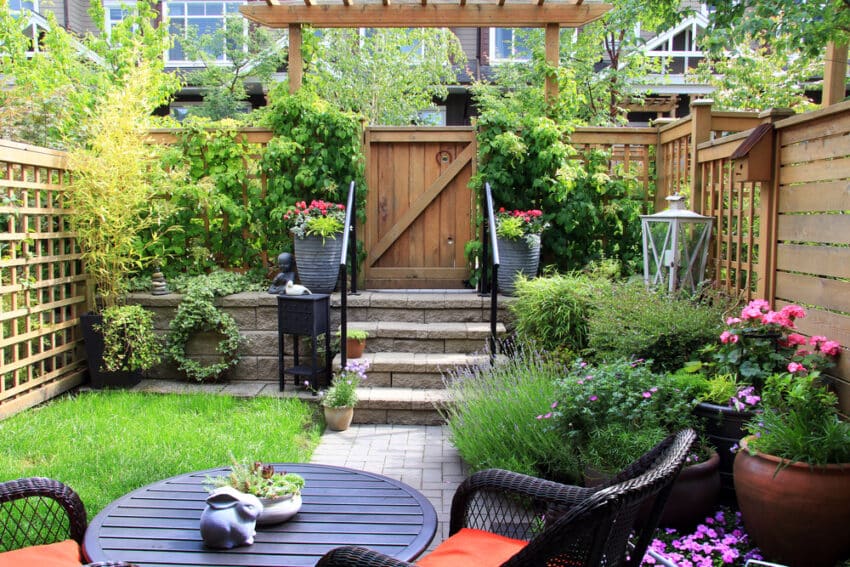Everyone loves a spacious garden that they can customise to their liking. However, urban living avails limited gardening spaces.
Nevertheless, all is not lost. With the proper tricks and tweaks, even tiny gardens can appear large. The following tips explain how to make a small garden look bigger.
Use Composite Decking
Adding levels in gardens can make them seem larger. One way is to use composite decking to create raised garden beds. Elevated beds create layers for growing different plants so that space looks larger. Apart from raised beds, composite decking is also applied in creating garden furniture and patios, which can work together to amplify the available space when blended with the flora.

Explore Vertical Spaces
The ability to explore two-dimensional space rests in not being tied to just one direction. In tiny gardens, the horizontal dimensions can be very limiting, but the vertical plane is limitless. One way to take advantage of the vertical space is by growing climbing plants on walls and fences. Alternatively, hanging plants in pots over the edges of the garden will provide space for more plants.
The other option is to incorporate tall plants. These can be lined along the edge to create a high-rise wall of vegetation. Inside this wall, grow shorter plants to create a layered texture, making the place look bigger.
Incorporate Curves and Arches
Straight and narrow can be tedious and confining. It would be best if you strayed away from the regular square or rectangular garden designs. Instead, employ the allure of sweeping curves and shapes that include arches. Small gardens may not allow for designs exclusively built with curves. The trick is to end the arches with straight or angled lines and keep the curves at the minimum. Using fewer turns means they can be longer and thus create the feeling of vast space. The idea can be as simple as making a curved edge of bricks or a circle of grass in the garden. Creating a contrast between curves helps to emphasise them.
Use Outdoor Mirrors
How about using the reflective properties of a mirror to trick the eyes into seeing more space? Grab any mirrors lying around and create an illusion of extra space up to double the real size. When strategically placed in the garden, reflective surfaces can act both as decorators and space creators. Angled mirrors prevent harmful reflective effects and capture and expand fascinating sections of the garden. Moreover, hiding the mirror frame and surrounding it with foliage can help to create an illusion of even greater space.
Set Your Priorities Right
The challenge with small gardens is choosing what to include and exclude. Most gardening enthusiasts make the mistake of cramping up all the plants they like to have. Gradually they choke up all the space creating a messy and non-appealing garden area.
By all means, avoid a crowded space. Create a prioritised list of favourites that deserve a spot in the garden and follow it strictly. Keep out everything that is not listed. The fewer plants there are, the easier it is to manage and keep organised.
Invest in a Good Garden Layout
More than anything, the layout determines how big a garden will feel. There are ready-to-use layout templates on the internet that can be customised to suit particular needs. Additionally, gardening apps can help design a personalised layout, depending on the garden’s size. The layout will help to keep the garden organised. When everything is in its right place, space appears bigger.
If you have the budget, you might want to consult with the experts in Garden Design Gloucestershire. Not only they will help you in preparing for the ideal garden layout, but they can also assist you in the proper installation and aftercare of your garden.
Segment the Garden into Specialised Spaces
If the garden includes specialised amenities like a sitting area or a barbecue spot, delineating the spaces will be crucial. The garden should be segmented into parts reserved for different purposes. A quick example is to use a staircase to separate the flowers section from the patio.
Create a Forced Perspective
The forced perspective is a trick borrowed from renaissance painters. The idea is to make a small space look longer. By using a passageway sandwiched between straight edges, painters create a finish that looks elongated. The same principle applies to making a small garden look huge. Include a path that cuts through consecutive rows of plants to achieve the elongation effect.
Use Fewer but Bigger Pots
The use of pots instead of traditional farming in the open ground helps to fit in more plants in a small place. However, having many small planting vessels, usually with planter box inserts inside, makes the garden look congested and a few large pots are more appropriate.
Additionally, growing a few big plants is a better way to create space than many small plants. You should invest in massive plants with a few small plants to fill the gaps in between.
All the above tips can be applied to expand a small garden space. You can use one option or combine several solutions to achieve better results.


